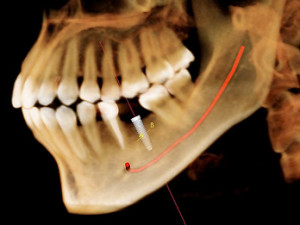When a tooth is extracted, the area beneath the tooth may be left uneven or jagged. This bone is where a denture will sit. In order for the denture to feel comfortable and fit well in the mouth, the bone may need to be reshaped or leveled. Pre-prosthetic procedures include:
- Removal of excess bone
- Removal of excess gum tissue
- Bone ridge reduction
- Bone leveling and reshaping
There are several anesthetic options when receiving pre-prosthetic surgery, including local anesthesia, intravenous (IV) sedation, and Nitrous Oxide Gas (laughing gas). Dr. Farbod will discuss with you the best anesthetic option for your treatment.
For many patients, dental implants are a better solution for tooth replacement. See the “Dental Implants” section in the menu for more information.
 When preparing the mouth for dental implants, occasionally there is a need to move the nerve which gives feeling to the lower lip and chin (inferior alveolar nerve). It is a procedure considered to be an aggressive approach, and other options are considered before deciding to proceed with nerve repositioning. This is because there is almost always some postoperative numbness of the lower lip and jaw, which dissipates very slowly, if ever.
When preparing the mouth for dental implants, occasionally there is a need to move the nerve which gives feeling to the lower lip and chin (inferior alveolar nerve). It is a procedure considered to be an aggressive approach, and other options are considered before deciding to proceed with nerve repositioning. This is because there is almost always some postoperative numbness of the lower lip and jaw, which dissipates very slowly, if ever.
However, the procedure does allow for the placement of longer implants, thereby improving implant longevity. It can also be used to preserve the alveolar nerve during resection of benign tumors or cysts.
During the procedure, Dr. Farbod will remove an outer section of the cheek side of the lower jawbone. The nerve and vessel canal is exposed, allowing it to be pulled slightly out to the side. When the implants are placed, this neuro-vascular bundle is carefully maintained in position, then released and placed over the implants. Open areas are filled with bone graft material, and the site is then closed.
Dr. Farbod will discuss the most appropriate type of anesthesia, but typically this procedure is performed in the office surgery under Intravenous (IV) sedation or general anesthesia.
